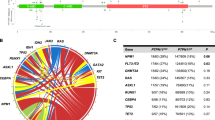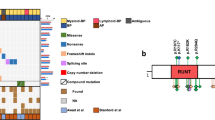Abstract
Acute lymphoblastic leukemia (ALL) is an aggressive hematological tumor resulting from the malignant transformation of lymphoid progenitors. Despite intensive chemotherapy, 20% of pediatric patients and over 50% of adult patients with ALL do not achieve a complete remission or relapse after intensified chemotherapy, making disease relapse and resistance to therapy the most substantial challenge in the treatment of this disease1,2. Using whole-exome sequencing, we identify mutations in the cytosolic 5′-nucleotidase II gene (NT5C2), which encodes a 5′-nucleotidase enzyme that is responsible for the inactivation of nucleoside-analog chemotherapy drugs, in 20/103 (19%) relapse T cell ALLs and 1/35 (3%) relapse B-precursor ALLs. NT5C2 mutant proteins show increased nucleotidase activity in vitro and conferred resistance to chemotherapy with 6-mercaptopurine and 6-thioguanine when expressed in ALL lymphoblasts. These results support a prominent role for activating mutations in NT5C2 and increased nucleoside-analog metabolism in disease progression and chemotherapy resistance in ALL.
This is a preview of subscription content, access via your institution
Access options
Subscribe to this journal
Receive 12 print issues and online access
$209.00 per year
only $17.42 per issue
Buy this article
- Purchase on Springer Link
- Instant access to full article PDF
Prices may be subject to local taxes which are calculated during checkout




Similar content being viewed by others
References
Möricke, A. et al. Long-term results of five consecutive trials in childhood acute lymphoblastic leukemia performed by the ALL-BFM study group from 1981 to 2000. Leukemia 24, 265–284 (2010).
Salzer, W.L. et al. Long-term results of the pediatric oncology group studies for childhood acute lymphoblastic leukemia 1984–2001: a report from the children′s oncology group. Leukemia 24, 355–370 (2010).
Koren, G. et al. Systemic exposure to mercaptopurine as a prognostic factor in acute lymphocytic leukemia in children. N. Engl. J. Med. 323, 17–21 (1990).
Relling, M.V., Hancock, M.L., Boyett, J.M., Pui, C.H. & Evans, W.E. Prognostic importance of 6-mercaptopurine dose intensity in acute lymphoblastic leukemia. Blood 93, 2817–2823 (1999).
Pui, C.H. & Evans, W.E. Treatment of acute lymphoblastic leukemia. N. Engl. J. Med. 354, 166–178 (2006).
Tallen, G. et al. Long-term outcome in children with relapsed acute lymphoblastic leukemia after time-point and site-of-relapse stratification and intensified short-course multidrug chemotherapy: results of trial ALL-REZ BFM 90. J. Clin. Oncol. 28, 2339–2347 (2010).
Gaynon, P.S. et al. Survival after relapse in childhood acute lymphoblastic leukemia: impact of site and time to first relapse—the Children′s Cancer Group Experience. Cancer 82, 1387–1395 (1998).
Tosello, V. et al. WT1 mutations in T-ALL. Blood 114, 1038–1045 (2009).
Mullighan, C.G. et al. Genomic analysis of the clonal origins of relapsed acute lymphoblastic leukemia. Science 322, 1377–1380 (2008).
Clappier, E. et al. Clonal selection in xenografted human T cell acute lymphoblastic leukemia recapitulates gain of malignancy at relapse. J. Exp. Med. 208, 653–661 (2011).
Thompson, B.J. et al. The SCFFBW7 ubiquitin ligase complex as a tumor suppressor in T cell leukemia. J. Exp. Med. 204, 1825–1835 (2007).
Zhang, J. et al. The genetic basis of early T-cell precursor acute lymphoblastic leukaemia. Nature 481, 157–163 (2012).
Jalota, A. et al. Tumor suppressor SMAR1 activates and stabilizes p53 through its arginine-serine–rich motif. J. Biol. Chem. 280, 16019–16029 (2005).
Zhang, Y. et al. Ribosomal protein L11 negatively regulates oncoprotein MDM2 and mediates a p53-dependent ribosomal-stress checkpoint pathway. Mol. Cell. Biol. 23, 8902–8912 (2003).
Hof, J. et al. Mutations and deletions of the TP53 gene predict nonresponse to treatment and poor outcome in first relapse of childhood acute lymphoblastic leukemia. J. Clin. Oncol. 29, 3185–3193 (2011).
Bunz, F. et al. Disruption of p53 in human cancer cells alters the responses to therapeutic agents. J. Clin. Invest. 104, 263–269 (1999).
Lübbert, M. et al. N-ras gene point mutations in childhood acute lymphocytic leukemia correlate with a poor prognosis. Blood 75, 1163–1169 (1990).
Van Vlierberghe, P. et al. ETV6 mutations in early immature human T cell leukemias. J. Exp. Med. 208, 2571–2579 (2011).
Coustan-Smith, E. et al. Early T-cell precursor leukaemia: a subtype of very high-risk acute lymphoblastic leukaemia. Lancet Oncol. 10, 147–156 (2009).
Oka, J., Matsumoto, A., Hosokawa, Y. & Inoue, S. Molecular cloning of human cytosolic purine 5′-nucleotidase. Biochem. Biophys. Res. Commun. 205, 917–922 (1994).
Spychała, J., Madrid-Marina, V. & Fox, I.H. High Km soluble 5′-nucleotidase from human placenta. Properties and allosteric regulation by IMP and ATP. J. Biol. Chem. 263, 18759–18765 (1988).
Brouwer, C. et al. Role of 5′-nucleotidase in thiopurine metabolism: enzyme kinetic profile and association with thio-GMP levels in patients with acute lymphoblastic leukemia during 6-mercaptopurine treatment. Clin. Chim. Acta 361, 95–103 (2005).
Hunsucker, S.A., Mitchell, B.S. & Spychala, J. The 5′-nucleotidases as regulators of nucleotide and drug metabolism. Pharmacol. Ther. 107, 1–30 (2005).
Galmarini, C.M., Jordheim, L. & Dumontet, C. Role of IMP-selective 5′-nucleotidase (cN-II) in hematological malignancies. Leuk. Lymphoma 44, 1105–1111 (2003).
Pieters, R. et al. Relation of 5′-nucleotidase and phosphatase activities with immunophenotype, drug resistance and clinical prognosis in childhood leukemia. Leuk. Res. 16, 873–880 (1992).
Allegrini, S. et al. Mechanistic studies on bovine cytosolic 5′-nucleotidase II, an enzyme belonging to the HAD superfamily. Eur. J. Biochem. 271, 4881–4891 (2004).
Sanford, M. & Lyseng-Williamson, K.A. Nelarabine. Drugs 68, 439–447 (2008).
Berg, S.L. et al. Phase II study of nelarabine (compound 506U78) in children and young adults with refractory T-cell malignancies: a report from the Children′s Oncology Group. J. Clin. Oncol. 23, 3376–3382 (2005).
Gökbuget, N. et al. High single-drug activity of nelarabine in relapsed T-lymphoblastic leukemia/lymphoma offers curative option with subsequent stem cell transplantation. Blood 118, 3504–3511 (2011).
DeAngelo, D.J. et al. Nelarabine induces complete remissions in adults with relapsed or refractory T-lineage acute lymphoblastic leukemia or lymphoblastic lymphoma: Cancer and Leukemia Group B study 19801. Blood 109, 5136–5142 (2007).
Bhatia, S. et al. Nonadherence to oral mercaptopurine and risk of relapse in Hispanic and non-Hispanic white children with acute lymphoblastic leukemia: a report from the children′s oncology group. J. Clin. Oncol. 30, 2094–2101 (2012).
Tiacci, E. et al. BRAF mutations in hairy-cell leukemia. N. Engl. J. Med. 364, 2305–2315 (2011).
Pasqualucci, L. et al. Analysis of the coding genome of diffuse large B-cell lymphoma. Nat. Genet. 43, 830–837 (2011).
Pettersen, E.F. et al. UCSF Chimera—a visualization system for exploratory research and analysis. J. Comput. Chem. 25, 1605–1612 (2004).
Altschul, S.F. et al. Gapped BLAST and PSI-BLAST: a new generation of protein database search programs. Nucleic Acids Res. 25, 3389–3402 (1997).
Roy, A., Kucukural, A. & Zhang, Y. I-TASSER: a unified platform for automated protein structure and function prediction. Nat. Protoc. 5, 725–738 (2010).
Worth, C.L., Preissner, R. & Blundell, T.L. SDM—a server for predicting effects of mutations on protein stability and malfunction. Nucleic Acids Res. 39, W215–W222 (2011).
Acknowledgements
We thank A.A. Da Silva for technical support in the production of recombinant NT5C2 proteins and R. Parsons for insightful comments and advice. We also thank P.H. Wiernik as the Eastern Cooperative Oncology Group (ECOG) leukemia committee chair at the time the E2993 study was initiated. This work was supported by the St. Baldrick's Foundation (A.F.), the Partnership for Cure Foundation (R.R.), the Innovative Research Award by the Stand Up to Cancer Foundation (A.F.), the Chemotherapy Foundation (A.F.), the Leukemia and Lymphoma Society Scholar Award (A.F.), the German Federal Ministry for Education and Research in the National Genome Research Network (grant 01GS0870 to R.K.-S.), the German Foundation for Childhood Cancer (grants DKS 2003.08 and 2007.02 to R.K.-S.), the US National Institutes of Health (U24 CA114737 to E.P.) and the ECOG Leukemia Tissue Bank. A.P.-G. is a postdoctoral researcher funded by the Rally Foundation.
Author information
Authors and Affiliations
Contributions
G.T. and A.P.-G. performed validation and recurrence mutation analysis, enzymatic activity and cell drug-resistance assays. Z.C. performed structure function analysis and analyzed Illumina sequence data. H.K. analyzed Illumina sequence data. V.T. analyzed genomic data from diagnostic and relapse T-ALLs. M.A. performed validation analysis of Illumina sequencing results. M.P., G.B., E.P., J.R., J.H., J.M.R., M.S.T. and R.K.-S. contributed clinical samples and clinical correlative information. T.P. directed and supervised mutation analysis. R.R. directed and supervised the analysis of Illumina sequencing data. A.F. designed the study, directed and supervised research and wrote the manuscript.
Corresponding authors
Ethics declarations
Competing interests
The authors declare no competing financial interests.
Supplementary information
Supplementary Text and Figures
Supplementary Figures 1–3 and Supplementary Tables 1–11 (PDF 772 kb)
Rights and permissions
About this article
Cite this article
Tzoneva, G., Perez-Garcia, A., Carpenter, Z. et al. Activating mutations in the NT5C2 nucleotidase gene drive chemotherapy resistance in relapsed ALL. Nat Med 19, 368–371 (2013). https://doi.org/10.1038/nm.3078
Received:
Accepted:
Published:
Issue Date:
DOI: https://doi.org/10.1038/nm.3078
This article is cited by
-
Convergent TP53 loss and evolvability in cancer
BMC Ecology and Evolution (2023)
-
Chromatin accessibility landscape of relapsed pediatric B-lineage acute lymphoblastic leukemia
Nature Communications (2023)
-
Oncogenic KRAS alters splicing factor phosphorylation and alternative splicing in lung cancer
BMC Cancer (2022)
-
Pediatric T-ALL type-1 and type-2 relapses develop along distinct pathways of clonal evolution
Leukemia (2022)
-
The evolution of relapse of adult T cell acute lymphoblastic leukemia
Genome Biology (2020)



